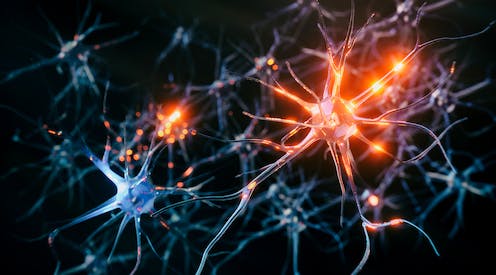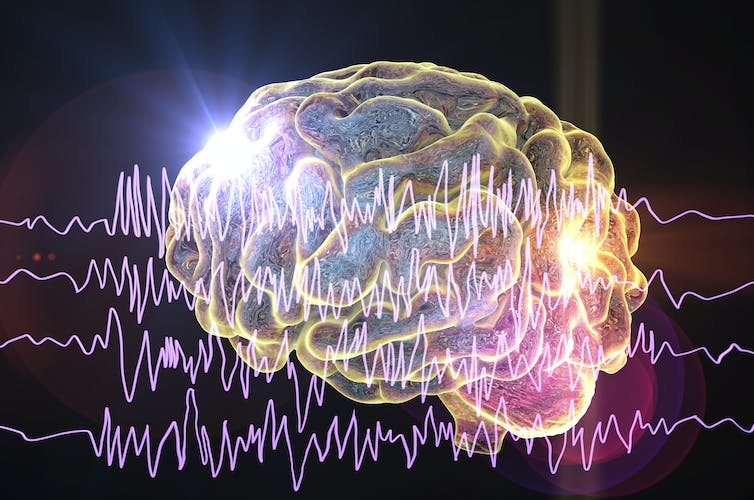
Approximately 1 in 26 people develop epilepsy, a condition in which someone experiences recurring and unprovoked seizures. But experiencing a seizure does not always mean a person has epilepsy. Seizures can be provoked by acute head injuries, alcohol withdrawal and high blood sugar, among other things. Approximately 1 in 10 people will experience a seizure during their lifetime.
The Conversation asked Dr. Jacob Pellinen, a neurologist specializing in epilepsy, to walk us through how to recognize a seizure in a bystander or loved one, and what to do in those crucial moments after a seizure begins.
Table of Contents
What does a seizure look like?
It varies. For some people, their seizure is a purely internal sensation. To an untrained observer, it may appear as though nothing’s wrong. In fact, most people with epilepsy have only relatively subtle, nonconvulsive seizures at first, then develop convulsive seizures over time.
But others having seizures experience full body convulsions with a loss of consciousness. This is the type of seizure most of us are familiar with, probably because it’s the kind most frequently depicted, though not always accurately, in movies and on television. It’s also the most dangerous type of seizure.
These kinds of seizures are sudden, unprovoked and last a couple of minutes. After recovering from the convulsions and loss of consciousness, the person is usually fatigued and confused for several minutes to several hours.
If someone has epilepsy, the seizures they experience will be very similar each time they occur. The most common type of epileptic seizure are those that are focal – that is, they arise from a confined region of the brain. This accounts for two-thirds of cases overall and 99% of cases that occur after the age of 25.
Epileptic seizures may begin with nonconvulsive symptoms, including staring, unresponsiveness, repetitive movements and purely internal sensations, which either stop or progress to convulsions and loss of consciousness.
What causes a seizure to occur?
Seizures are the result of abnormal electrical activity in the brain. The bursts of activity disrupt normal functioning and initiate hyperactivity in the affected brain area, which then can affect the corresponding body part.
For instance, if the seizure arises from the part of the brain involved in arm movement, that arm will experience involuntary hyperactivity.

Kateryna Kon/Science Photo Library via Getty Images
If you’re a bystander, how can you help?
First, keep the person safe. Many seizure-related injuries occur due to falling or coming in contact with sharp or hard objects. If they begin to fall, help them to the floor as gently as possible and put something soft under their head.
During the convulsive phase of a seizure, breathing may be intermittent. So turn the person on their side so they can breathe more easily and lower the risk of aspiration.
Do not put any objects into their mouth. This is unnecessary and dangerous. It is not possible to swallow your tongue.
Do not restrain or shout at them. Neither one of those things will stop the seizure.
Although not everyone with epilepsy has one, check for any visible medical identification such as a wristband.
If they stop convulsing, but remain unresponsive, continue to keep them on their side and monitor their breathing.
Following the seizure, and as the person gradually recovers and wakes up, help them sit up in a safe space. If they are confused, reorient them and don’t let them wander near roads, stairs or platforms.
Do not give them water or food until they are fully awake. Stay with them until they are fully alert. It’s also important to tell them what happened, and offer to help further.
Keeping track of time is critical. Call 911 if the seizures last more than five minutes or if they begin to cluster back to back, such as when another seizure begins before a person fully recovers from the first. Although rare, both of these situations are life-threatening emergencies.
You should also call 911 if the person continues to have difficulty breathing; if the person has a seizure in water or is pregnant; if it’s the first time they’ve had a seizure; or if they have the seizure without a diagnosis of epilepsy.
However, if a person diagnosed with epilepsy experiences a habitual seizure, recovers fully and does not experience any injury, they may not need to go to the emergency room for further evaluation. They should, however, call their doctor.
Are new treatments available?
People with epilepsy, particularly those who experience frequent seizures, will often have emergency medications in their possession.
The most common emergency medications – also called seizure rescue medications – are a type of anticonvulsants called benzodiazepines. The most common ones used are diazepam, clonazepam, lorazepam and midazolam.
All are fast-acting medications. Some are pills to be swallowed, others are dissolvable tablets placed in the cheek or under the tongue, and some are nasal sprays or gels for rectal administration. Patients and their caretakers may have access to rescue medications and know how to use them.
One cautionary note: If the medication is in pill form, and if the person is in the midst of a convulsive seizure, don’t put the pill in their mouth. But remember: Not all seizures are convulsive or cause a loss of consciousness. So if a person is awake and alert, they may be able to swallow a pill.
What if it’s not a seizure?
If a bystander does not witness a seizure, but instead finds someone unresponsive or minimally responsive, call 911. They may be suffering from other medical issues, such as a drug overdose.
And if you are interested in training and certification for seizure first aid, or if you simply want to know more, the Epilepsy Foundation has more information.
![]()
Jacob Pellinen has received research support from the Department of Neurology at the University of Colorado School of Medicine, the Colorado Clinical and Translational Sciences Institute, NIH/NINDS, and the American Epilepsy Society. J. Pellinen serves as chair of the professional advisory board for the Epilepsy Foundation of Colorado and Wyoming (unpaid), serves as the Epilepsy Section Editor for Current Neurology and Neuroscience Reports, and has received compensation for serving on the scientific advisory board for SK Life Science.























